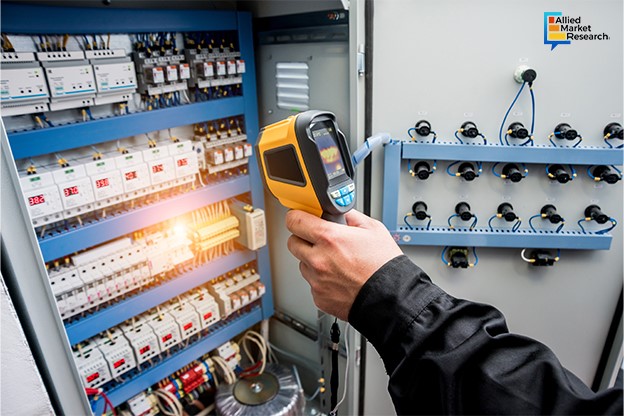Thermal Biosensors: Why Should Medical Device Manufacturers Take a Note of this Emerging Technology?

9 Apr
2024
Key takeaways:
- Introduction
- Working principle and benefits of thermal biosensors
- Recent developments in the industry
Modern medical devices use different types of sensors to diagnose symptoms and ascertain the nature of the disease. One such type is a biosensor which uses bioreceptors and transducers to generate an electronic signal as per the alterations of certain parameters like temperature and chemicals. The receptors used in such biosensors typically are biological components such as enzymes, tissues, cell receptors, antibodies, etc. These biological receptors help in the determination of the target analyte, while on the other hand, the transducer senses and measures the changes in the target analyte and converts the change into a measurable signal.
Depending upon the parameter to be tested, biosensors are classified into different types such as resonant biosensors, optical biosensors, electrochemical biosensors, bioluminescence sensors, nano biosensors, nucleic acid-based biosensors, and thermal sensors. As the name suggests, thermal biosensors use receptors and transducers to measure the change in temperature and heat and convert it into a tangible and measurable signal.
How have thermal biosensors helped in the development of modern medical devices?
A characteristic feature of living tissues and other similar biological components is that they continuously absorb and produce heat from their functioning and energy consumption. This production and absorption of heat results in temperature changes which, thus, signify a change in the functioning of the biological component. This temperature change can be measured using thermal biosensing technology to ascertain whether the production and absorption of heat follow a normal pattern. The results produced by this technology are then used by medical practitioners to determine the nature of the disease and prescribe a treatment course accordingly. The presence of external entities and pathogens such as bacteria, fungi, and viruses can also be detected using thermal biosensing devices as these pathogens have their distinctive heat patterns.
A majority of medical practitioners and doctors across the globe prefer medical devices that employ thermal biosensing technology due to some of its vital benefits. Firstly, thermal biosensing devices offer unmatched accuracy as they are insensitive to electrochemical or optical features and changes in the biological sample. Hence, these devices measure only the temperature changes in the sample, thereby producing results free from outside interferences. Also, since these devices are insensitive to other parameters, they do not require regular recalibration which makes them a perfect solution to detect the presence of different kinds of pathogens and parasites.
Apart from this, thermal biosensing devices offer the benefit of fast and continuous measurement of the temperature changes in the biological component which makes these devices a preferred solution for patients who need continuous monitoring. Also, the pace at which results are produced makes them a perfect solution for point-of-care medical devices. These devices, for instance, are widely used to determine glucose levels in diabetic patients. The point-of-care (POC) segment of the thermal biosensors industry is, hence, predicted to gather an absolute revenue of $2,212.9 million in the 2022-2032 timeframe.
Analyzing the latest trends in the thermal biosensor industry
In the past few years, private companies and universities have engaged in R&D activities to develop advanced thermal biosensing devices for diagnosing different ailments. Recently, in December 2023, a team of medical researchers was able to develop a handheld, non-invasive medical device for the detection of Parkinson’s and Alzheimer’s disease. This device uses different kinds of biosensors and is designed to test in vitro patient samples. The findings of this study also showed that this device's accuracy was significantly higher than the models that were previously tested.
To conclude, thermal biosensing devices are now increasingly being used in modern medical devices owing to the fast response time and accuracy offered by these devices. Furthermore, private companies, medical universities, and research organizations are actively engaging in R&D activities to develop new biosensing technologies that are expected to expand the scope of the industry in the coming period.
To get an in-depth analysis of the growth drivers and investment opportunities in the industry, feel free to contact us.

Akhilesh Prabhugaonkar
Author's Bio- Akhilesh Prabhugaonkar holds a bachelor’s degree in Electronics Engineering from the reputed Vishwakarma Institute of Technology. He has a special interest in the fields of forensics, world history, international relations and foreign policy, sports, agriculture, astronomy, security, and oceanography. An ardent bibliophile and melophile, Akhilesh loves to write on topics of his interest and various other societal issues. This love for writing made him enter the professional world of content writing and pursue his career in this direction.
Avenue: Entire Library membership of Allied Market Research Reports at your disposal
- Avenue is an innovative subscription-based online report database.
- Avail an online access to the entire library of syndicated reports on more than 2,000 niche industries and company profiles on more than 12,000 firms across 11 domains.
- A cost-effective model tailored for entrepreneurs, investors, and students & researchers at universities.
- Request customizations, suggest new reports, and avail analyst support as per your requirements.
- Get an access to the library of reports at any time from any device and anywhere.
Related Post
-
How are Submarine Cables Transforming Global Connectivity with Enhanced User Experience?
-
Endoscopy Procedures: Transformations in Techniques and Applications
-
AI-Powered Video Analytics: How the Product Actually Works for enterprises
-
Painting Robots: Transforming Precision Coating and Creative Applications
-
Innovations in Pharmacovigilance Systems Advancing Patient Safety
-
Understanding Edge Security: Keeping Data Safe Near the Source
-
Exploring the Use and Advancements of 3D Laser Scanners in Professional Applications
-
Reinforcing Industrial Controls with Smarter Tools and Training








